 "ttyymmnn" (ttyymmnn)
"ttyymmnn" (ttyymmnn)
03/02/2018 at 12:45 • Filed to: wingspan, Planelopnik, TDIAH
 13
13
 16
16
 "ttyymmnn" (ttyymmnn)
"ttyymmnn" (ttyymmnn)
03/02/2018 at 12:45 • Filed to: wingspan, Planelopnik, TDIAH |  13 13
|  16 16 |
!!! UNKNOWN CONTENT TYPE !!!
Welcome to
This Date in Aviation History
, getting of you caught up on milestones, important historical events and people in aviation from February 28 through March 2.
!!! UNKNOWN CONTENT TYPE !!!
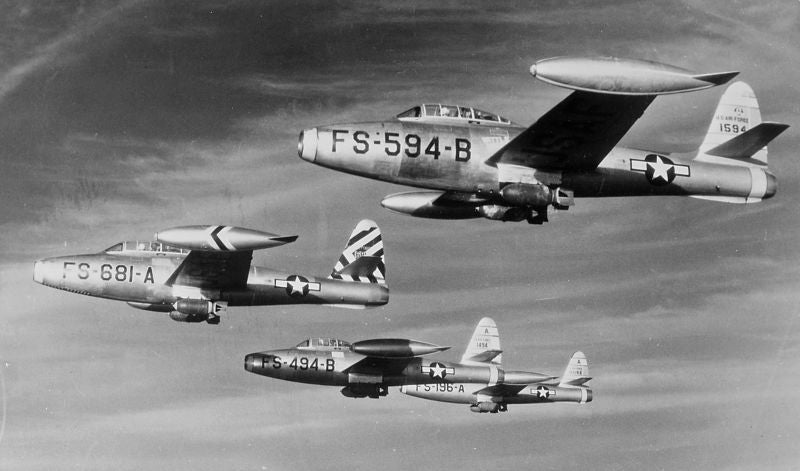
February 28, 1946 – The first flight of the Republic F-84 Thunderjet. The history of !!!error: Indecipherable SUB-paragraph formatting!!! begins with !!!error: Indecipherable SUB-paragraph formatting!!! , a WWI veteran and émigré from Russia who started an airplane factory in the US that bore his name. True to his Russian roots, he hired a number of designers from his home country, one of whom was !!!error: Indecipherable SUB-paragraph formatting!!! , a native of Tbilisi, Georgia. When Seversky was forced out as the head of the Seversky Aero Company in 1939, the company reorganized as Republic Aviation, but Kartveli stayed on, becoming the company’s chief engineer and designing arguably one of the greatest fighter-bombers of WWII, the !!!error: Indecipherable SUB-paragraph formatting!!! .
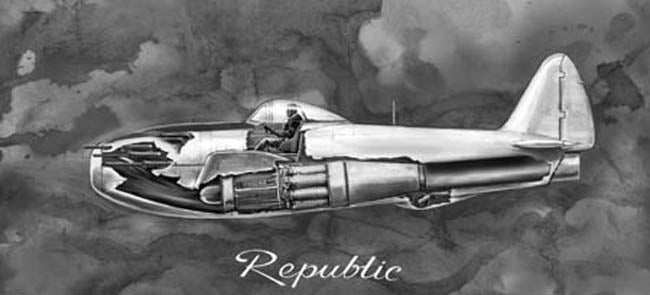
Republic’s first concept of placing a jet engine in a P-47
By 1944, Kartveli had begun initial design work on an aircraft that would be powered by the new !!!error: Indecipherable SUB-paragraph formatting!!! which had been pioneered separately by !!!error: Indecipherable SUB-paragraph formatting!!! in England and !!!error: Indecipherable SUB-paragraph formatting!!! in Germany. At first, Kartveli experimented with putting the engine into the fuselage of a P-47, but it proved too bulky, and the concept was abandoned. On September 11, 1944, the US Army Air Forces issued a requirement for a new day fighter powered by the !!!error: Indecipherable SUB-paragraph formatting!!! !!!error: Indecipherable SUB-paragraph formatting!!! turbojet, a much slimmer engine that was more suited to being placed inside the fuselage of a slender jet. The new fighter was required to have a top speed of 600 mph and be armed with either six .50 caliber or four .60 caliber machine guns.
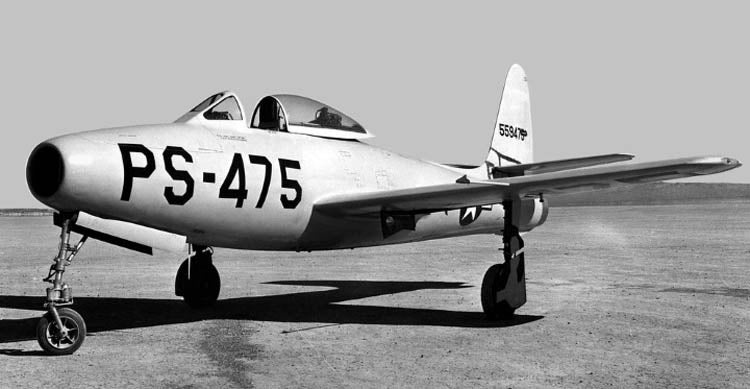
XP-84 Thunderjet prototype.
The USAAF ordered three prototypes from Republic, the first of which took its maiden flight on February 28, 1946. The second prototype flew six months later and immediately established a new world record speed of 611 mph. Instead of building a third prototype, production began on the F-84B, which was fitted with an ejection seat and wingtip fuel tanks for increased range. The Air Force received the first Thunderjets in 1947, but teething problems plagued the new fighter. Operational speeds were limited to Mach 0.8 due to problems with !!!error: Indecipherable SUB-paragraph formatting!!! , and acceleration was limited to 5.5g due to wrinkling of the fuselage skin. These problems were exacerbated by a chronic shortage of parts for the Allison engines, and the entire F-84B fleet was grounded in 1948 because of structural failures. The situation looked grim the the Thunderjet, and there was talk of canceling the entire program. Fortunately for the Thunderjet, many of the structural problems were already being addressed in the F-84D, which featured thicker, stronger wings, an upgraded and winterized fuel system, and the addition of small wings to the wingtip fuel tanks to eliminate stress on the wings during high G maneuvers.
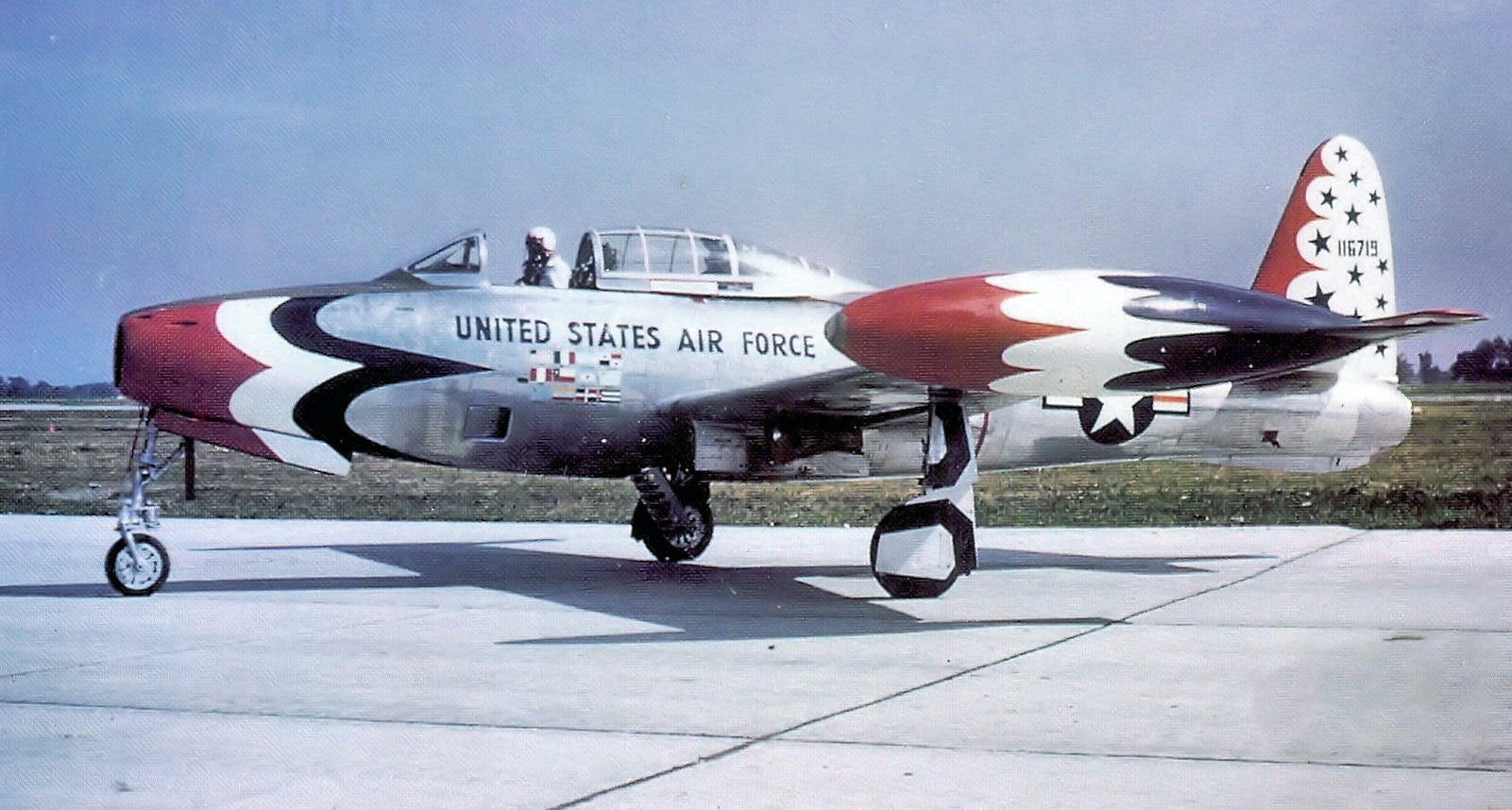
Republic F-84G of the USAF Thunderbirds
Despite its initial shortcomings, the F-84 served with great distinction in the Korean War. Thunderjets were used as bomber escorts, and though it was outmatched by the Russian-built swept-wing !!!error: Indecipherable SUB-paragraph formatting!!! , the F-84 scored its first air-to-air kill in 1951, though two Thunderjets were lost in the encounter. Ultimately, F-84 pilots claimed victories over eight MiG-15s over the course of 86,408 sorties. Armed with bombs and rockets to supplement its machine guns, the Thunderjet became a potent ground attack aircraft, claiming 60% of all ground targets destroyed during the war and dropping 55,586 tons of bombs. The F-84 was also the first American fighter to carry out mid-air refueling. The Thunderjet was widely exported to America’s allies, and it was also the first aircraft flown by the !!!error: Indecipherable SUB-paragraph formatting!!! demonstration team from 1953-1955. Its basic design served as the foundation for the swept-wing !!!error: Indecipherable SUB-paragraph formatting!!! and RF-84F Thunderflash, and just over 7,500 Thunderjets were produced. They type was retired from frontline Air Force service in the mid-1960s. (US Air Force photos; illustration author unknown; )
!!! UNKNOWN CONTENT TYPE !!!
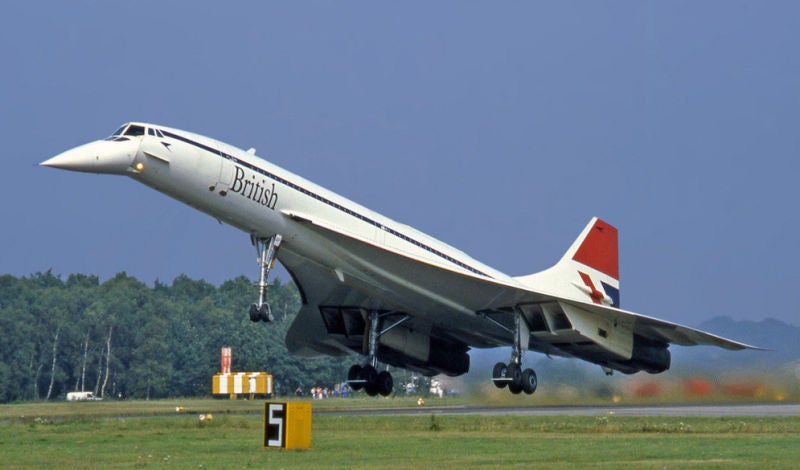
March 2, 1969 – The first flight of the Aérospatiale/British Aircraft Corporation Concorde. The evolution of the airplane has branched out in many directions, and the airplane has taken many forms, but perhaps one constant throughout its developmental history has been the quest for speed. In 1903, the Wright Brothers’ first flight covered the ground at a speed of 6.8 mph, but a mere 44 years later Chuck Yeager flew the !!!error: Indecipherable SUB-paragraph formatting!!! past the speed of sound. Even though supersonic flight was mainly the purview of the world’s militaries in those days and remains so to this day, work soon began to see how supersonic technology might be applied to commercial aircraft, with the English and French both working individually on their own solutions.
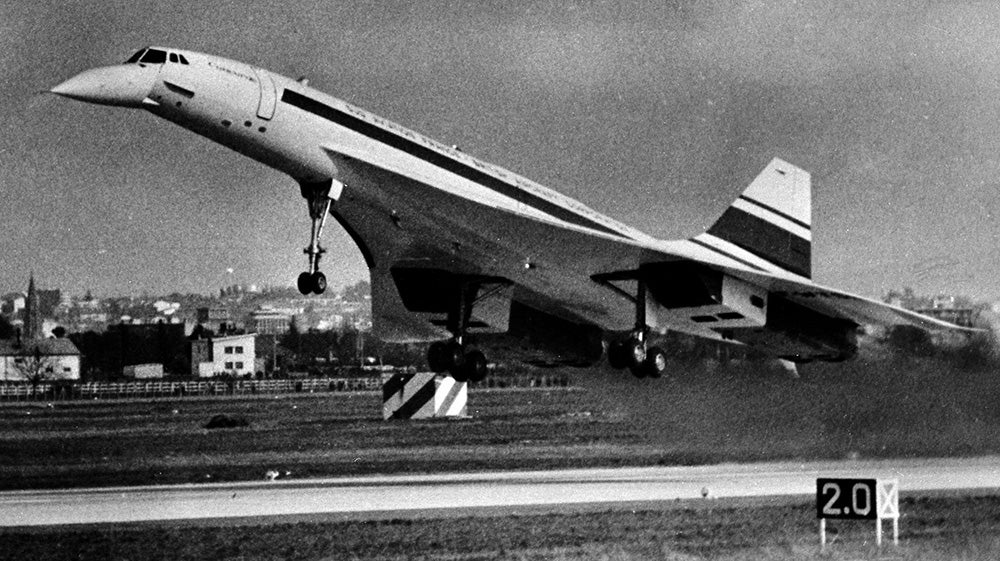
Concorde 001 (F-WTSS) takes off on its maiden flight on March 2, 1969.
In the early 1950s, the !!!error: Indecipherable SUB-paragraph formatting!!! in England formed the Supersonic Transport Aircraft Committee to study the concept of a supersonic airliner. After considerable research on various design possibilities, they settled on an !!!error: Indecipherable SUB-paragraph formatting!!! planform for the wing, with a slender fuselage to reduce drag. Their work culminated in the !!!error: Indecipherable SUB-paragraph formatting!!! , an airliner that would have seated about 100 passengers with a top speed of Mach 2, though it never progressed beyond the design phase. On the other side of the English Channel, the French were also investigating a supersonic airliner, and had come to many of the same design conclusions reached by the British. However, their concept for the !!!error: Indecipherable SUB-paragraph formatting!!! , while similar in shape, was significantly smaller, and was envisioned more as a replacement for the Caravelle airliner and not for transatlantic flights. With both countries working towards essentially the same goal, it became obvious that an international partnership would best serve their interests (and help compete against the US dominance in commercial airliner production, including Boeing’s work on its own supersonic airiner, the !!!error: Indecipherable SUB-paragraph formatting!!! ). In November 1963, the United Kingdom and France signed a treaty binding the two countries to work together on the project, and the name Concorde was chosen in honor of this landmark international agreement. Construction of two prototypes began in 1965, the first in France (001) and the second in England (002). The French Concorde flew first on March 2, 1969, followed a month later by the English Concorde on April 9, 1969. Ultimately, 20 Concordes were built, six of which were prototypes and used for development and testing. Air France and British Airways each received seven aircraft.
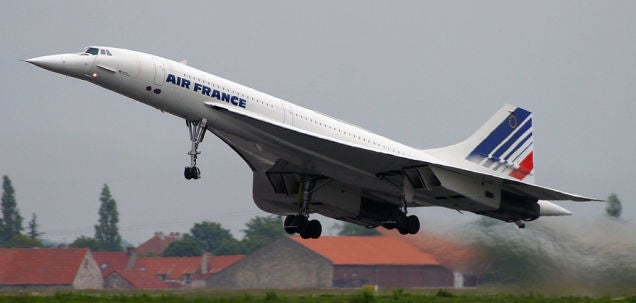
Air France Concorde (F-BTSD) in 2003
Concorde entered service with British Airways on January 21, 1976 flying between London and Bahrain while Air France pioneered supersonic passenger service between Paris and Rio de Janeiro. British Airways flew daily between New York and London, and weekly flights to Barbados during the holiday season. They also served Dallas, Miami, Singapore, Toronto, and Washington, DC. Air France flew between Paris and New York five times a week, as well as scheduled flights to Caracas, Mexico, Rio, and Washington, DC. Concorde’s four !!!error: Indecipherable SUB-paragraph formatting!!! afterburning turbojets provided a maximum cruising speed of Mach 2.04, and cut the flying time between transatlantic destinations in half when compared to traditional airliners, with flights averaging about 3 hours 30 minutes. Concorde set a number of records, including the fastest eastward transatlantic flight that departed on February 7, 1996 from New York’s JFK International and touched down at London Heathrow in just 2 hours, 52 minutes, 59 seconds. Concorde also set records for circumnavigation of the globe in both directions, though with numerous refueling stops along the way.
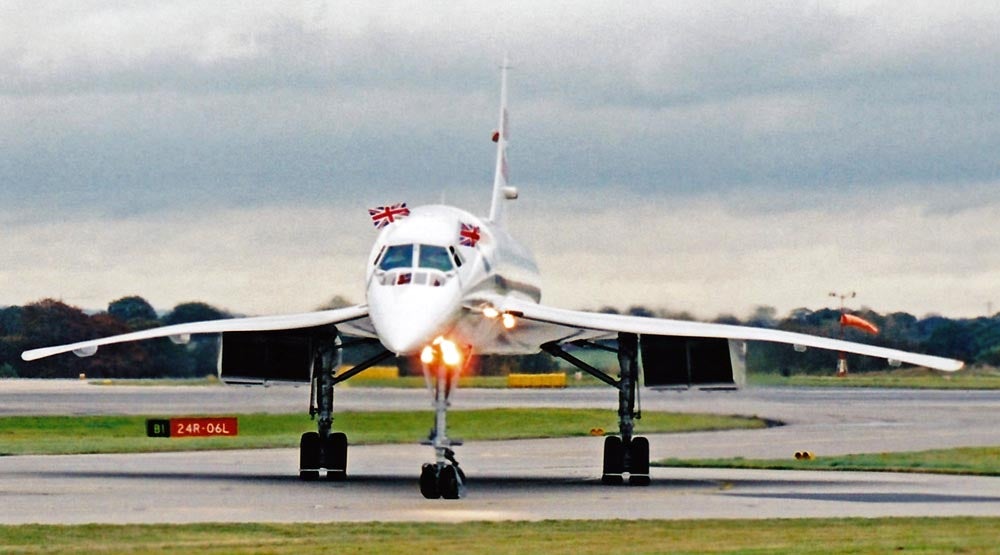
British Airways Concorde G-BOAC arrives at Manchester after its final flight in 2003
The 14 operational Concordes enjoyed a remarkable safety record, though there were two non-fatal accidents and a spate of tire failures throughout their service history. The only loss of a Concorde occurred on July 25, 2000 when !!!error: Indecipherable SUB-paragraph formatting!!! (F-BTSC) crashed shortly after takeoff from Charles de Gaulle airport. After debris on the runway punctured a tire and ruptured the fuel tank, the burning airliner crashed into a hotel, killing all 100 passengers, 9 crew, and 4 persons on the ground. Following the crash, all Concordes were grounded until safety improvements could be made, and service resumed in November 2001. Though the crash didn’t lead directly to the end of Concorde flights, its service days were numbered. The 2000 crash caused fewer people to book flights on Concorde, and there was also a general drop in all passenger numbers following the !!!error: Indecipherable SUB-paragraph formatting!!! . Concorde’s high fuel costs and small passenger capacity meant that the SST had never been a money-maker for the airlines and, with rising maintenance costs also figuring into the balance sheet, Air France and British Airways made the decision to retire Concorde in 2003. Twelve of the original 14 operational aircraft were dispersed to display sites in Europe, the US, and Barbados. Of the remaining two, one aircraft was lost in the 2000 crash, and the other was used for spare parts and scrapped in 1994. (Photo by Ralf Manteufel via !!!error: Indecipherable SUB-paragraph formatting!!! ; photo by André Cros via !!!error: Indecipherable SUB-paragraph formatting!!! ; photo by Alexander Jonsson via !!!error: Indecipherable SUB-paragraph formatting!!! ; photo by Ken Fielding via !!!error: Indecipherable SUB-paragraph formatting!!! )
!!! UNKNOWN CONTENT TYPE !!!
Short Takeoff
!!! UNKNOWN CONTENT TYPE !!!
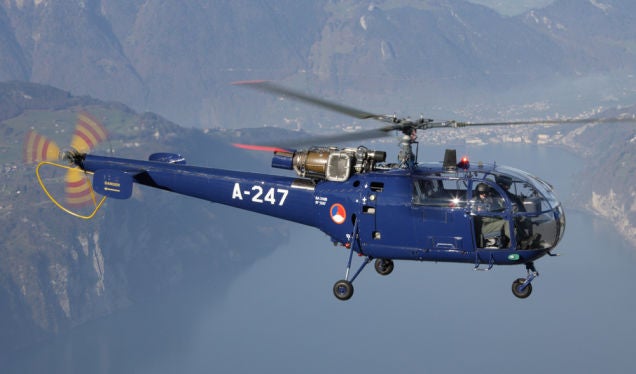
February 28, 1959 – The first flight of the Aérospatiale Alouette III,
a single-engine utility helicopter developed by
!!!error: Indecipherable SUB-paragraph formatting!!!
as an enlarged variant of the earlier
!!!error: Indecipherable SUB-paragraph formatting!!!
. Production of the Alouette III was performed by
!!!error: Indecipherable SUB-paragraph formatting!!!
, and the helicopter was also built under license in India and Romania. Over 2,000 copies of the Alouette III were produced between 1961-1985, and it remains in production in India. With a crew of two pilots, the Alouette III has space for five passengers and is used primarily for civilian or troop transport and search and rescue (SAR), though a number of variants were developed into helicopter gunships by Romania and South Africa.
(Ministerie van Defensie photo via
!!!error: Indecipherable SUB-paragraph formatting!!!
)
!!! UNKNOWN CONTENT TYPE !!!
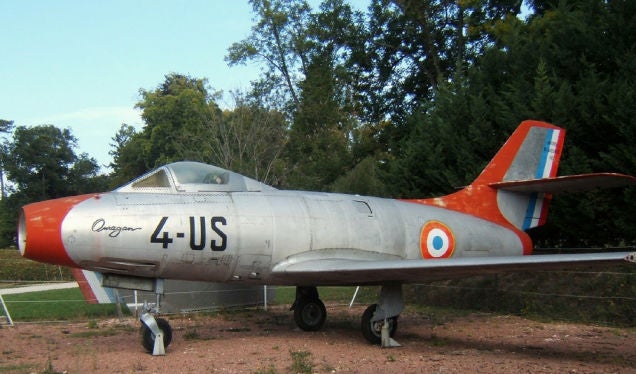
February 28, 1949 – The first flight of the Dassault Ouragan,
the first French-designed jet fighter to enter production. As an occupied country, France was largely left out of the rapid development of aircraft during WWII. Designer
!!!error: Indecipherable SUB-paragraph formatting!!!
and the Ouragan (Hurricane) were instrumental in reestablishing France as a player in the world of modern aircraft design and production. The Ouragan was powered by a single
!!!error: Indecipherable SUB-paragraph formatting!!!
turbojet, had a top speed of 584 mph and was armed with four 20mm cannons. It could also carry up to 16 rockets or 5,000 pounds of bombs. The Ouragan entered service with the Armée de l’Air in 1951, replacing the
!!!error: Indecipherable SUB-paragraph formatting!!!
, and also served in India, Israel and El Salvador.
(Photo by Groumfy69 via
!!!error: Indecipherable SUB-paragraph formatting!!!
)
!!! UNKNOWN CONTENT TYPE !!!
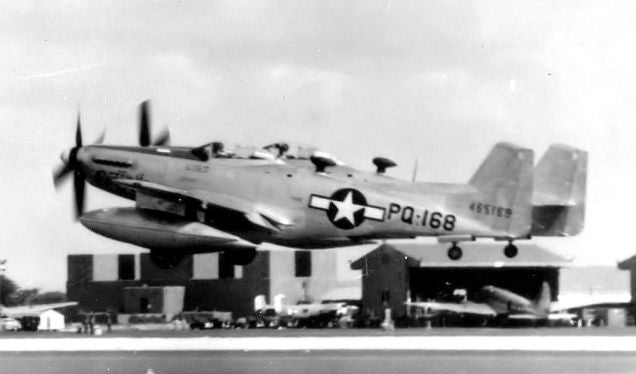
February 28, 1947 – The crew of a North American F-82 Twin Mustang sets a world record for the longest and fastest flight of a piston-powered fighter.
To demonstrate the long distance capabilities of the F-82, US Army Air Forces pilot
!!!error: Indecipherable SUB-paragraph formatting!!!
, with co-pilot Lieutenant John Ard, flew from
!!!error: Indecipherable SUB-paragraph formatting!!!
in Hawaii to
!!!error: Indecipherable SUB-paragraph formatting!!!
in New York City in a
!!!error: Indecipherable SUB-paragraph formatting!!!
nicknamed
Betty Jo
(they took off on the 27th, but landed on the 28th). The nonstop flight, without aerial refueling, lasted just over 14 hours at an average speed of 342 mph. Thacker’s and Ard’s flight set the world record for the longest non-stop flight by a piston-powered fighter, as well as the fastest non-stop flight by piston-powered aircraft from Hawaii to New York City, both records that still stand to this day.
(US Air Force photo)
!!! UNKNOWN CONTENT TYPE !!!
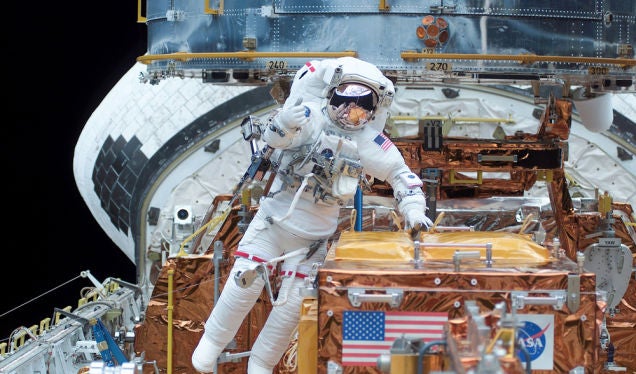
March 1, 2002 – The launch of the Space Shuttle Columbia on STS-109, the last successful mission of Columbia . STS-109 marked the 27th flight of !!!error: Indecipherable SUB-paragraph formatting!!! and the 108th mission of the !!!error: Indecipherable SUB-paragraph formatting!!! . The flight was the first for Columbia after undergoing a 2.5 year modification program, and the mission was highlighted by the installation of a new camera, new solar arrays, and a new power unit on the !!!error: Indecipherable SUB-paragraph formatting!!! (HST), the third of five Hubble servicing missions. STS-109 was also the final successful flight of Columbia . The orbiter was !!!error: Indecipherable SUB-paragraph formatting!!! on February 1, 2003 during !!!error: Indecipherable SUB-paragraph formatting!!! when it disintegrated while reentering Earth’s atmosphere after a piece of insulation foam damaged the wing during launch. Columbia burned up in the atmosphere with the loss of seven astronauts. (NASA photo)
!!! UNKNOWN CONTENT TYPE !!!
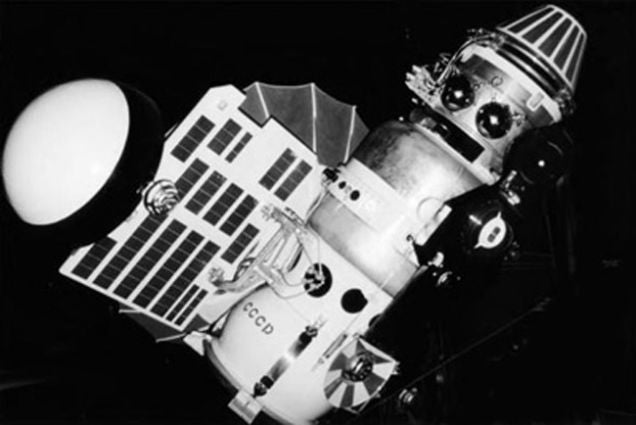
March 1, 1966 – The Soviet space probe Venera 3 crash lands on Venus. The Soviet !!!error: Indecipherable SUB-paragraph formatting!!! was a series of space probes launched between 1961 and 1984 to study the planet Venus. Venera 3 (the lander is the small, cone-shaped portion at the top of the spacecraft) was launched from !!!error: Indecipherable SUB-paragraph formatting!!! , Kazakhstan on November 16, 1965, and its mission was to land on the surface of our solar system’s second planet to study magnetic fields, cosmic rays, solar plasma and micrometeorites. Unfortunately, radio contact with the probe was lost during landing, and the spacecraft most likely crashed. Nevertheless, the probe owns the distinction of being the first manmade spacecraft to impact the surface of another planet. (Photo author unknown)
!!! UNKNOWN CONTENT TYPE !!!
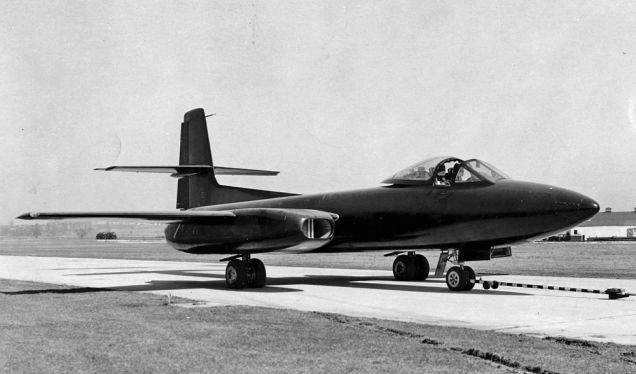
March 1, 1948 – The first flight of the Curtiss-Wright XF-87 Blackhawk, a prototype all-weather fighter/interceptor developed by the !!!error: Indecipherable SUB-paragraph formatting!!! as a successor to the !!!error: Indecipherable SUB-paragraph formatting!!! . Curtiss-Wright initially proposed a twin-engine jet fighter, but the Air Force rejected their proposal because the engines weren’t powerful enough for the 32,000-pound airframe. So Curtiss-Wright altered their plans to meet the new Army requirement and added two more engines. Flight tests showed the Blackhawk to be an acceptable aircraft, though the first engines were underpowered, and the Blackhawk suffered from buffeting that was never entirely solved. Following an upgrade to more powerful !!!error: Indecipherable SUB-paragraph formatting!!! turbojets, the XF-87 showed promise, and the USAAF placed orders for 57 aircraft, but the Blackhawk ultimately lost out to the !!!error: Indecipherable SUB-paragraph formatting!!! . Only two prototypes were built, and the loss of the Army Air Forces contract led to the demise of Curtiss-Wright. (US Air Force photo)
!!! UNKNOWN CONTENT TYPE !!!
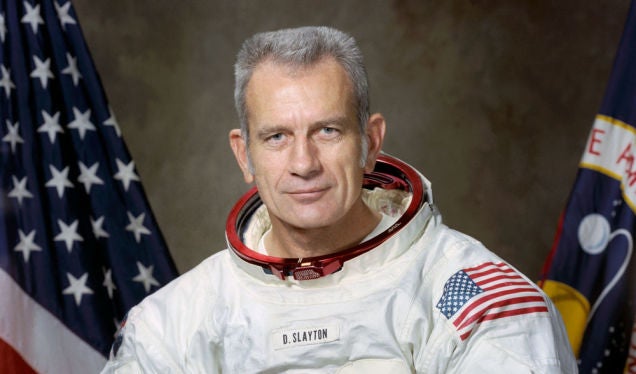
March 1, 1924 – The birth of Donald Kent “Deke” Slayton. Slayton was born in Sparta, Wisconsin and enlisted in the US Army Air Forces in 1942 where he trained as a bomber pilot flying the !!!error: Indecipherable SUB-paragraph formatting!!! and !!!error: Indecipherable SUB-paragraph formatting!!! . Following the war, Slayton served as a test pilot and, in 1958, was chosen along with six others to form the !!!error: Indecipherable SUB-paragraph formatting!!! , America’s first group of astronauts. Due to an irregular heartbeat, Slayton was the only member of the group never to fly a !!!error: Indecipherable SUB-paragraph formatting!!! mission, but he remained in NASA service as the Chief of the Astronaut Office and later as the Director of Flight Crew Operations. Slayton finally went to space as a member of the !!!error: Indecipherable SUB-paragraph formatting!!! that saw a Soviet and an American spacecraft dock together in Earth orbit. Slayton played a managerial role in the !!!error: Indecipherable SUB-paragraph formatting!!! , and retired from NASA in 1982. Slayton died on June 13, 1993. (NASA photo)
!!! UNKNOWN CONTENT TYPE !!!
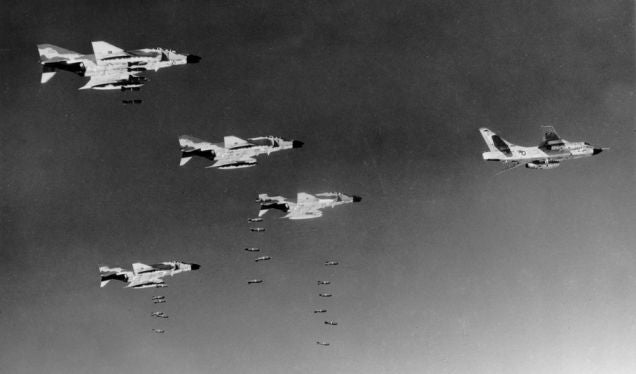
March 2, 1965 – The start of Operation Rolling Thunder, a sustained campaign of aerial bombardment against North Vietnam that lasted more than three years. The prolonged campaign’s goal was to boost South Vietnamese morale, stop the North Vietnamese government from its support of Communist rebels in the south, destroy the transportation system of North Vietnam, and prevent the flow of war materiel into the south. American and South Vietnamese aircraft faced dogged and sophisticated resistance to the attacks, and over 900 aircraft were lost, resulting in the death of 255 USAF pilots with 222 captured, while the US Navy and Marine Corps suffered 454 pilots killed, captured or missing. Despite 864,000 tons of bombs dropped over the course of 300,000 sorties, Rolling Thunder was ultimately unsuccessful. (US Air Force photo)
!!! UNKNOWN CONTENT TYPE !!!
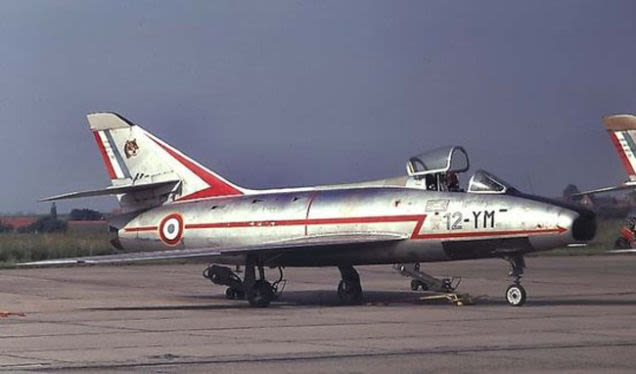
March 2, 1955 – The first flight of the Dassault Super Mystère, a French-built fighter-bomber and the first Western European supersonic aircraft to enter mass production. The Super Mystère is the ultimate evolution of the !!!error: Indecipherable SUB-paragraph formatting!!! , which had in turn been developed into the !!!error: Indecipherable SUB-paragraph formatting!!! and !!!error: Indecipherable SUB-paragraph formatting!!! . The Super Mystère was the first in the series to achieve supersonic speeds in level flight. Following its introduction in 1957, the Super Mystère served with the French Armée de l’Air until 1977. It was also exported to Honduras and Israel, where it saw action in the !!!error: Indecipherable SUB-paragraph formatting!!! and the !!!error: Indecipherable SUB-paragraph formatting!!! . A total of 180 aircraft were built. (Photo author unknown)
!!! UNKNOWN CONTENT TYPE !!!
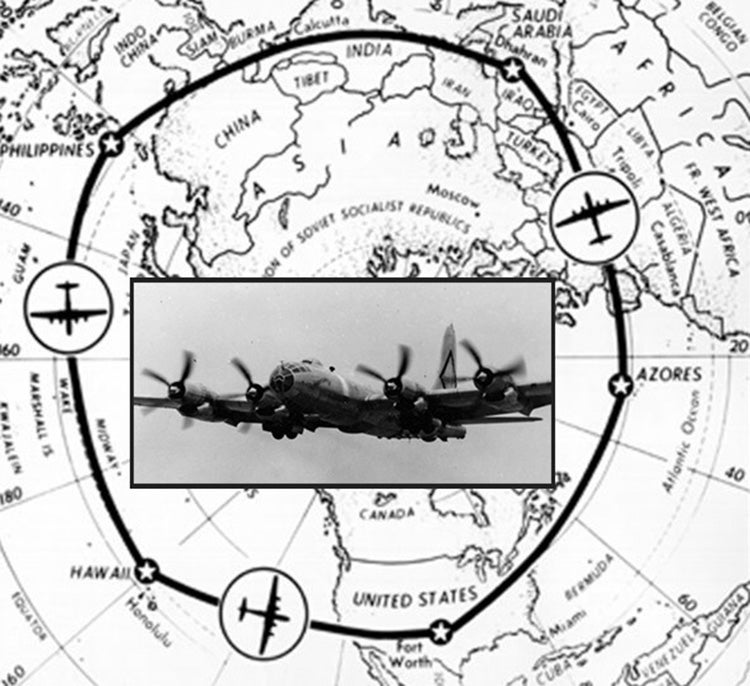
March 2, 1949 –
The crew of
Lucky Lady II
completes the first non-stop circumnavigation of the globe.
Lucky Lady II
was a US Air Force
!!!error: Indecipherable SUB-paragraph formatting!!!
belonging to the
!!!error: Indecipherable SUB-paragraph formatting!!!
. At the time of its round-the-world flight, the B-50 still had all of its defensive armament, though the bomb bay was fitted with an additional fuel tank.
Luck Lady II
was manned by a double crew, and each crew took turns flying the aircraft in six-hour shifts throughout the 94-hour flight. Departing from Carswell AFB in Texas,
Lucky Lady II
flew an easterly route, was refueled by aerial tankers four times along the way, and returned to Carswell AFB on March 2. For their roles in the mission, each member of the crew was awarded the
!!!error: Indecipherable SUB-paragraph formatting!!!
.
(US Air Force photo)
!!! UNKNOWN CONTENT TYPE !!!
Connecting Flights
!!! UNKNOWN CONTENT TYPE !!!
!!! UNKNOWN CONTENT TYPE !!!
!!! UNKNOWN CONTENT TYPE !!!
!!! UNKNOWN CONTENT TYPE !!!
!!! UNKNOWN CONTENT TYPE !!!
If you enjoy these Aviation History posts, please let me know in the comments. And if you missed any of the past articles, you can find them all at
!!!error: Indecipherable SUB-paragraph formatting!!!
. You can also find more stories about aviation, aviators and airplane oddities at
!!!error: Indecipherable SUB-paragraph formatting!!!
.
!!! UNKNOWN CONTENT TYPE !!!
 Smallbear wants a modern Syclone, local Maple Leafs spammer
> ttyymmnn
Smallbear wants a modern Syclone, local Maple Leafs spammer
> ttyymmnn
03/02/2018 at 13:02 |
|
One of my favorite stories about the Concorde was from when they were still trying to sell other airlines on it—particularly Pan Am. As a demonstration of it’s speed Air France had a Paris-bound Concorde take off from New York at the same time as a regularly scheduled New York bound 747 coming from Paris. The Concorde reached Paris, refueled, and flew back to New York—landing well ahead of the 747.
 Mercedes Streeter
> ttyymmnn
Mercedes Streeter
> ttyymmnn
03/02/2018 at 13:02 |
|
To me the Concorde is a reminder that at least for now, commercial aviation has moved past trying out bonkers ideas, instead opting for more incremental and less experimental changes.
Now everyone makes planes that to the untrained eye all look the same, are similar inside, and aren’t too much different from one another. Of course, that’s good for profits and good for passengers who just want to get to their destination.
At least you can still find some interesting designs in business jets.
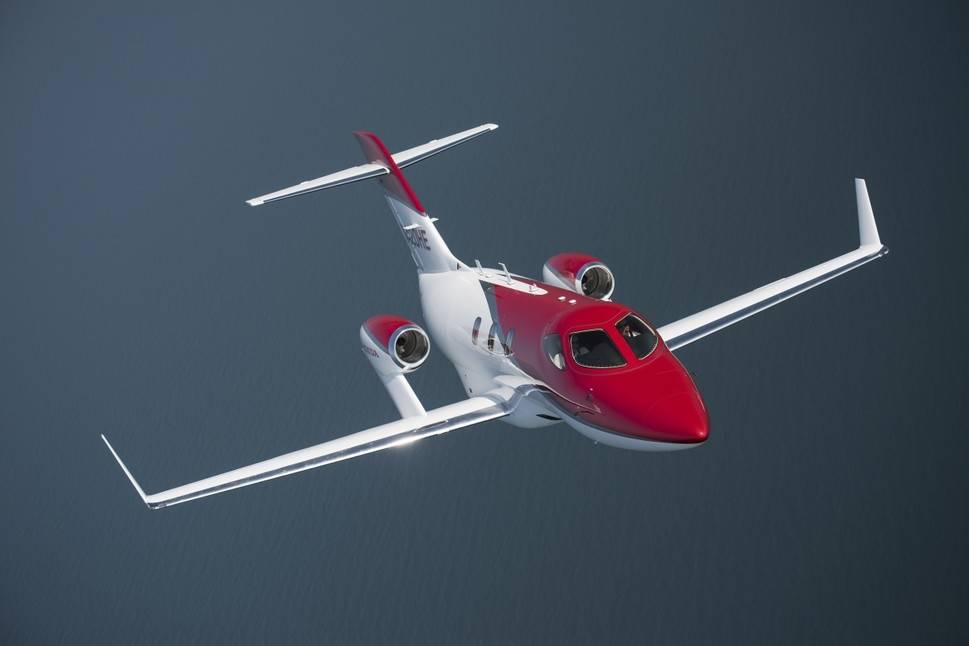
 user314
> ttyymmnn
user314
> ttyymmnn
03/02/2018 at 13:13 |
|
And the Betty Jo is one of two F-82s at the USAFM in Dayton.
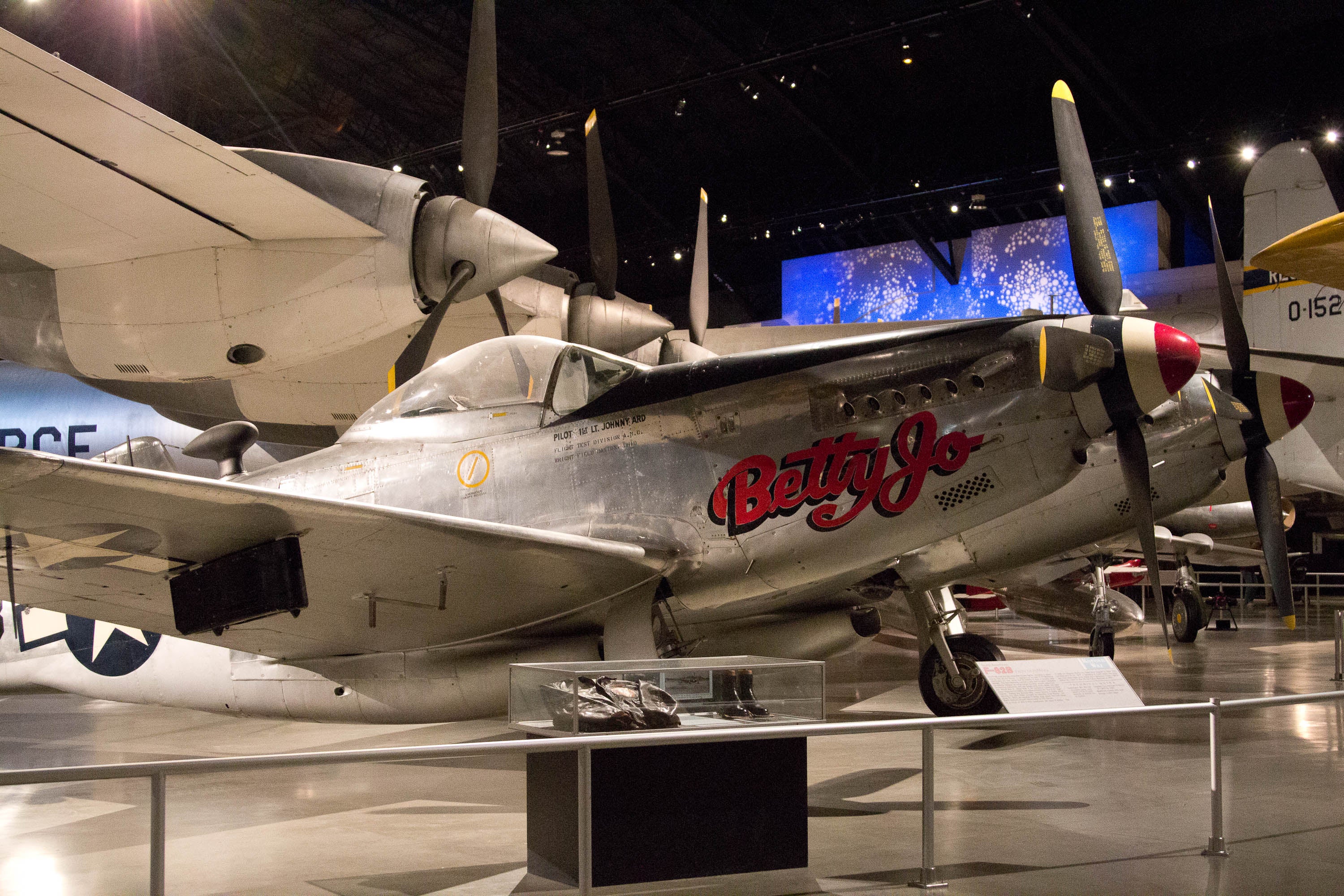
 facw
> Mercedes Streeter
facw
> Mercedes Streeter
03/02/2018 at 13:16 |
|
The HondaJet’s configuration is not entirely novel:
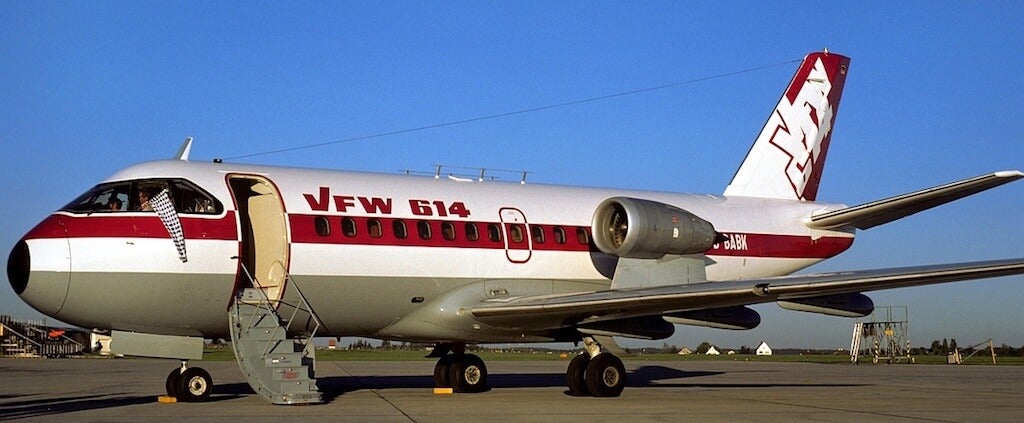
 ttyymmnn
> user314
ttyymmnn
> user314
03/02/2018 at 13:21 |
|
Yup. And here’s the other one. I’ve got pics of Jetty Jo from our visit last summer as well.
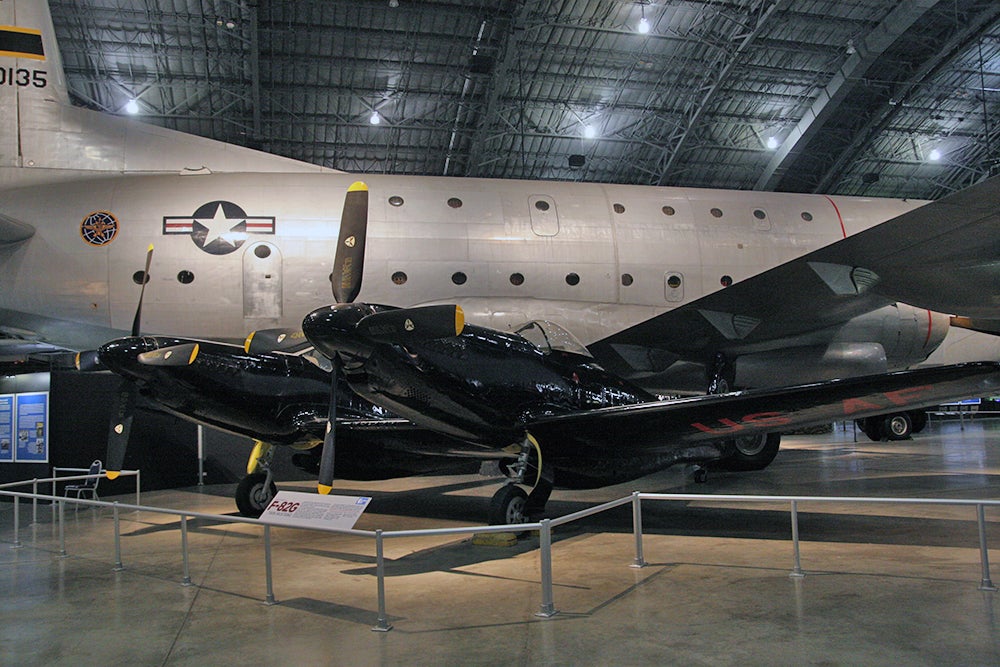
 Cé hé sin
> ttyymmnn
Cé hé sin
> ttyymmnn
03/02/2018 at 14:18 |
|
In November 1963, England and France signed a treaty binding the two countries to work together on the project, and the name Concorde was chosen in honor of this landmark international agreement
Strictly speaking the treaty was between the UK and France. England is in the UK but the terms aren’t interchangeable.
 Bo Knows
> ttyymmnn
Bo Knows
> ttyymmnn
03/02/2018 at 15:08 |
|
I’ve seen the Twin Mustang before but was unaware of its role in the early days of the Korean conflict. I always thought of it as a WW2 oddity that never served a real purpose. Oops.
 CKeffer
> ttyymmnn
CKeffer
> ttyymmnn
03/02/2018 at 15:19 |
|
I always love these posts. Did you hear that there is a Ford Tri-Motor currently touring the US, and that rides are available? https://www.eaa.org/en/eaa/flight-experiences/fly-the-ford-eaa-ford-tri-motor-airplane-tour/ford-tri-motor-tour-stops
 user314
> Bo Knows
user314
> Bo Knows
03/02/2018 at 15:28 |
|
Yup. The first three NorK aircraft shot down during the conflict were by radar-equipped F-82Gs.
Before dawn on 27 June, the 347th Provisional Group was up in the air over Korea, with a mission to provide cover for the Douglas C-54 Skymaster transports flying in and out of Kimpo Airfield as they moved the last civilians out. Fearing that the North Korean Air Force might try to shoot down the transport (a C-54 had been destroyed on the ground at Kimpo by North Korean fighters on 25 June), the Air Force requested air cover to protect the aircraft during takeoff. Fortunately, 339th Fighter All Weather Squadron (F(AW)S) with their F-82Gs were based at Yokota AB and the 68th F(AW)S was based at Itazuke AB Japan. With Lieutenant Colonel John F. Sharp in command, 27 F-82Gs of the 35 in Japan answered the call. Arriving in the early morning, they orbited Kimpo Airfield in three flights, each above the other. Suddenly, at 1150 hours, a mixed group of five North Korean fighters (Soviet-built Yak-9s , Yak-11s and La-7s ) appeared, heading for the airfield. One of the Yak-11s immediately scored several hits on 68th F(AW)S pilot Lt. Charles Moran’s vertical stabilizer. Moments later, Lt. William G. “Skeeter” Hudson, also of the 68th F(AW)S, initiated a high-G turn to engage the Yak, and soon was closing in on the Yak’s tail. He then fired a short burst at close range, scoring hits with his six .50 inch machine guns. The Yak banked hard to the right, with the F-82G in close pursuit. A second burst hit the Yak’s right wing, setting the gas tank on fire and knocking off the right flap and aileron. The North Korean pilot bailed out, but his observer, who was either dead or badly wounded, remained in the doomed aircraft. Parachuting down to Kimpo Airfield, the North Korean pilot was immediately surrounded by South Korean soldiers. Surprisingly, he pulled out a pistol and began firing at them. The South Korean soldiers returned fire, killing him. Moments later, Lt. Moran shot down an La-7 over the airfield, while a few miles away, Major James W. Little, commanding officer of the 339th F(AW)S, shot down another La-7. The C-54 was able to escape safely. Three of the five North Korean aircraft had been shot down, with pilot Lt. William G. “Skeeter” Hudson and radar operator Lt. Carl Fraiser scoring the first United States aerial “kill” of the Korean War.

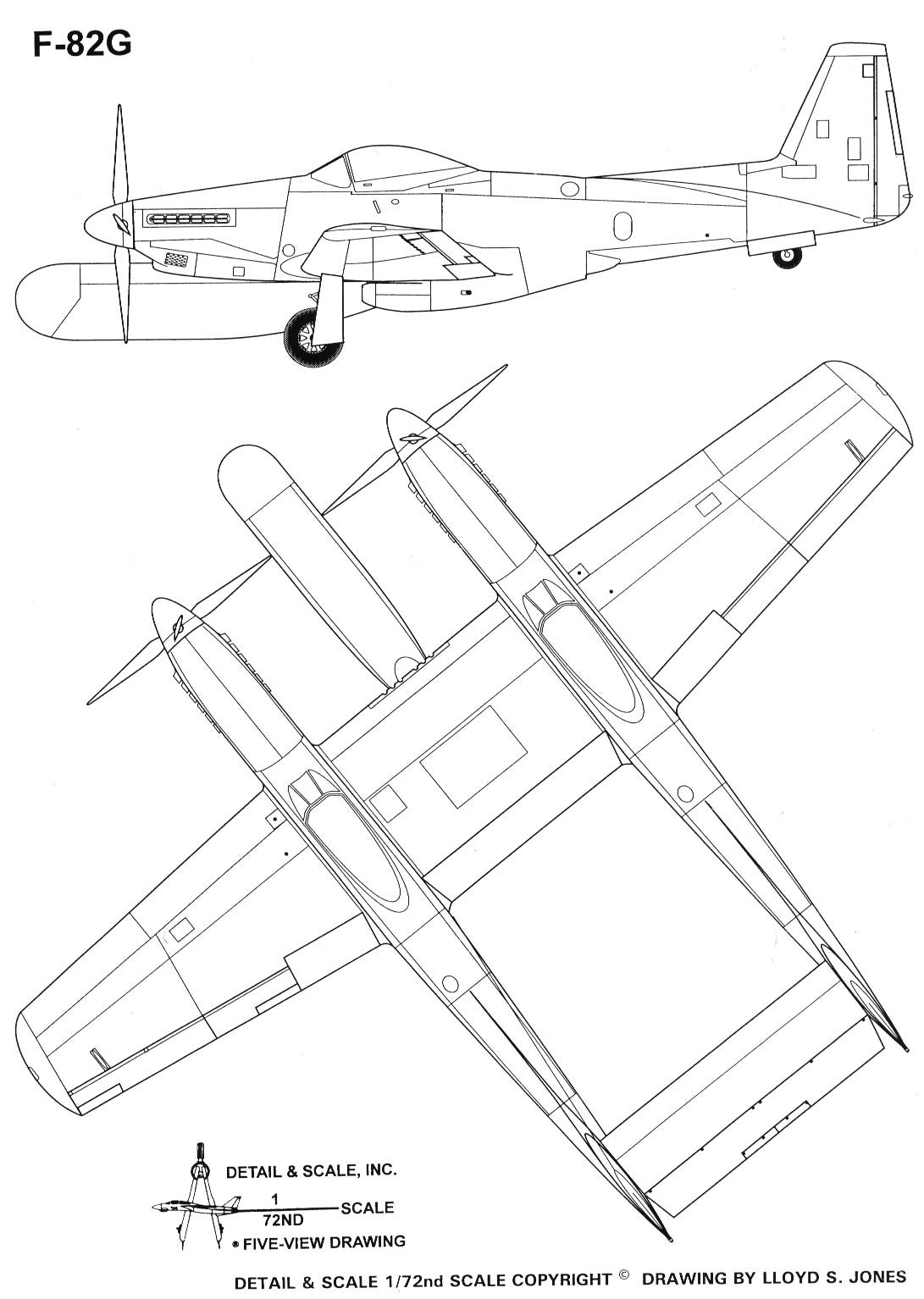
 Mercedes Streeter
> facw
Mercedes Streeter
> facw
03/02/2018 at 16:07 |
|
Touche!! WHAT IS THAT LOVELY THING? :D
 ttyymmnn
> CKeffer
ttyymmnn
> CKeffer
03/02/2018 at 16:22 |
|
Funny you should mention that....
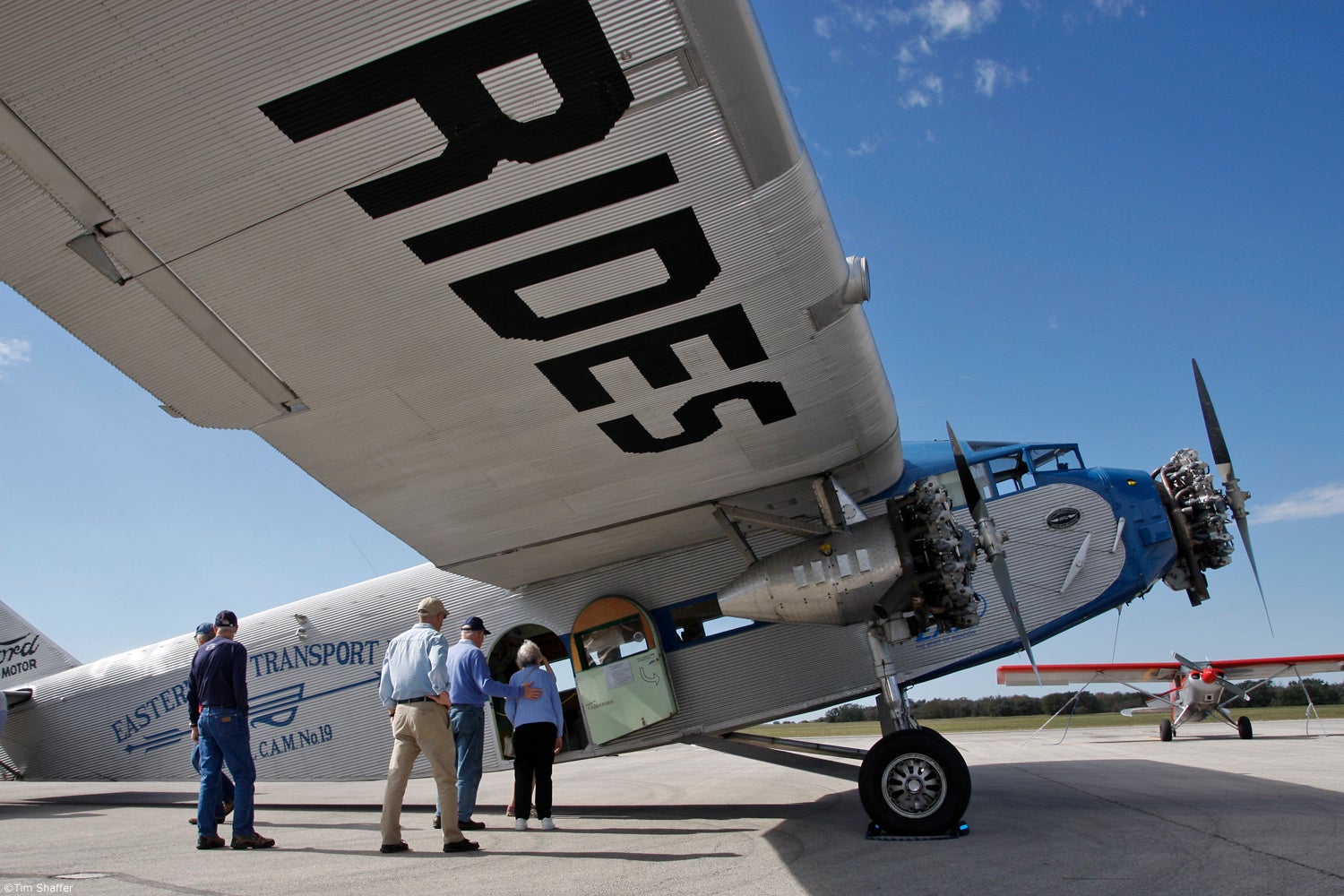
A couple of years ago, EAA’s 4-AT-E Trimotor came to Austin. I took a bunch of pictures of it , though I did not go up for a ride.
Thanks for reading! It’s been more than three years that I’ve been doing this (I think), and I’m still having lots of fun with it.
 facw
> Mercedes Streeter
facw
> Mercedes Streeter
03/02/2018 at 16:25 |
|
VFW-Fokker 614: https://en.wikipedia.org/wiki/VFW-Fokker_614
Not a successful plane, though they did have a few in service.
This one flew until a few years ago, as a testing aircraft:
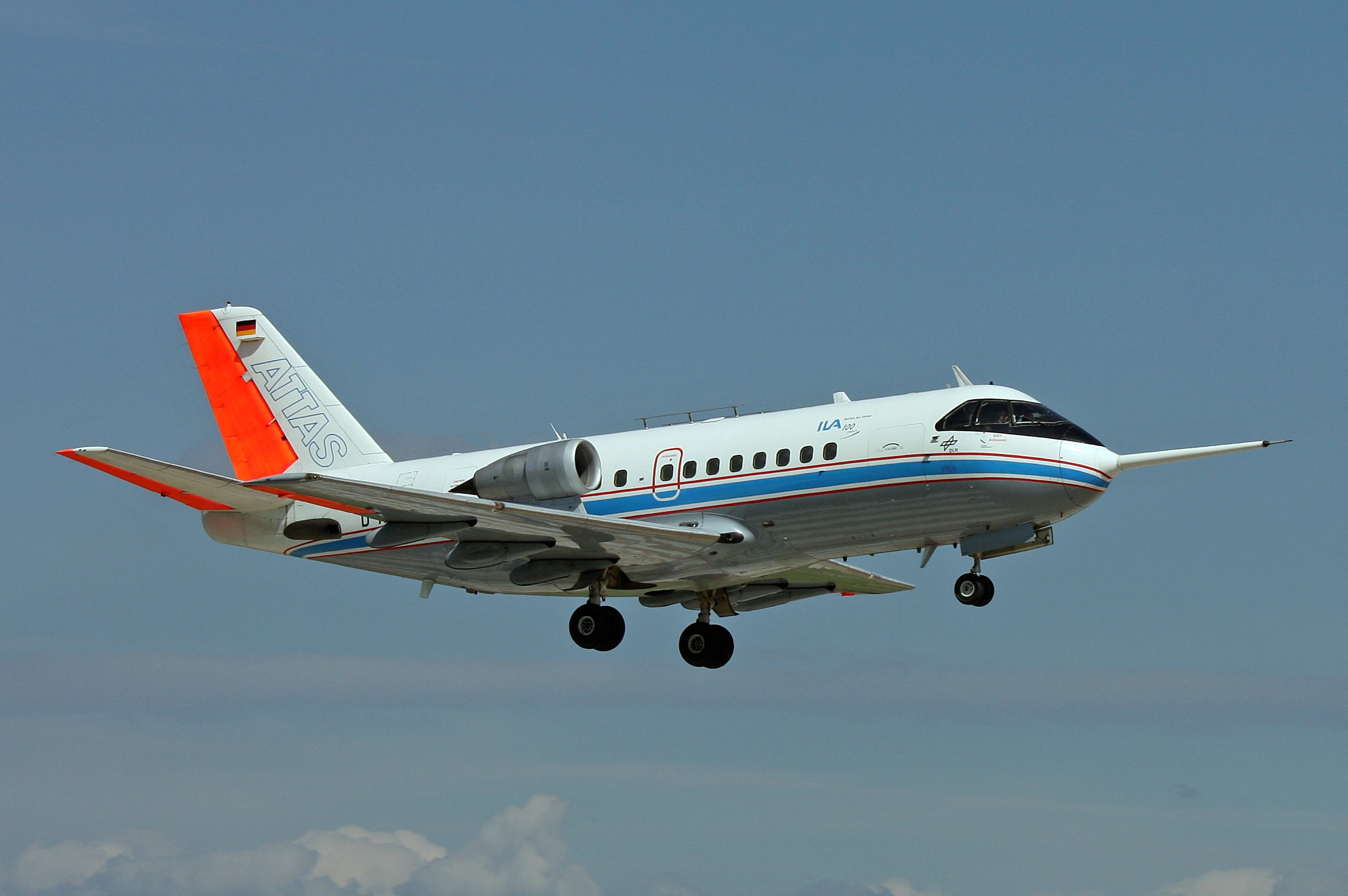
 ttyymmnn
> user314
ttyymmnn
> user314
03/02/2018 at 16:29 |
|
“Drawing by Lloyd S. Jones”
Lloyd Jones put out a series of books on military aircraft back in the mid-1970s: U.S. Fighters , U.S. Naval Fighters , and U.S. Bombers . They trace the development of the types from the WWI to the then-present (the F-18 is still an artist’s render). Nevertheless, they remain excellent basic references for historic planes, and they are still available through Amazon or other used book sellers.
 ttyymmnn
> Cé hé sin
ttyymmnn
> Cé hé sin
03/02/2018 at 16:32 |
|
I do understand the difference, and you are correct. At least I know somebody is reading! Thanks.
 Mercedes Streeter
> facw
Mercedes Streeter
> facw
03/02/2018 at 16:43 |
|
I’m in love! It’s so adorable!
 CKeffer
> ttyymmnn
CKeffer
> ttyymmnn
03/05/2018 at 11:01 |
|
Very cool! I’m debating getting tickets for myself and my F-I-L for when it comes through Houston, but haven’t decided yet. As for the posts, I never fail to learn something from each one, so I’ll quite happily read them as long as you keep posting them! :)